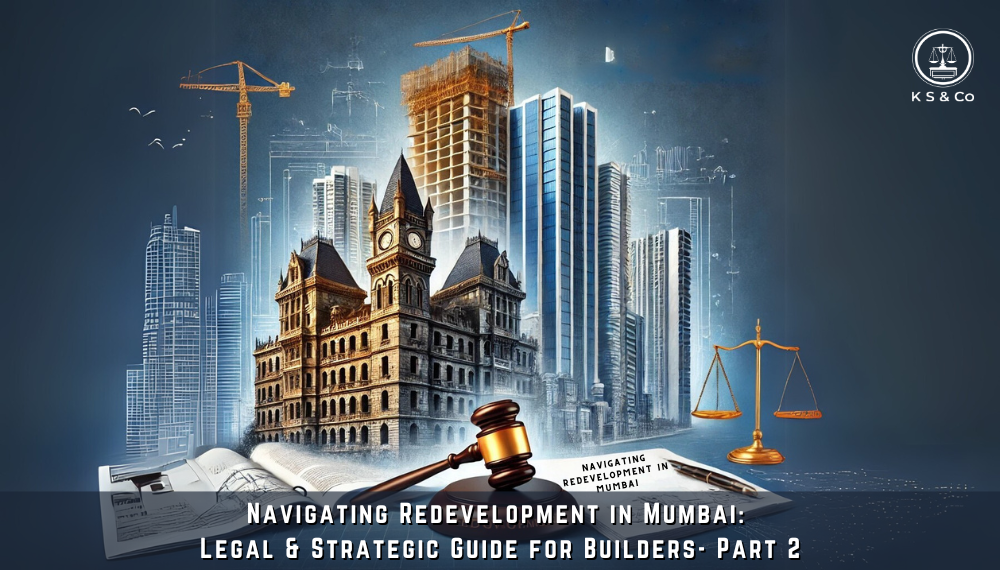Recent Bombay High Court rulings have significantly impacted redevelopment projects in Mumbai, shaping how builders, housing societies, and tenants navigate legal challenges. These judgments clarify tenant rights, redevelopment autonomy, insolvency issues, and regulatory compliance—all crucial for ensuring smooth project execution.
In this edition, we break down four landmark cases and their implications for redevelopment stakeholders.
1️⃣ Deterrence Against Frivolous Litigation
Khimjibhai Patadia vs Municipal Corporation of Greater Mumbai
Citation: WRIT PETITION (L) NO. 30632 OF 2024
Coram: A. S. Gadkari, J. and Kamal Khata, J.
Ruling:
The Court ruled that tenants cannot misuse legal petitions to obstruct redevelopment of dilapidated buildings. It emphasized that structural disputes are technical matters best left to experts, not courts.
 Case Facts:
Case Facts:
The petitioner, a tenant in an 83-year-old building, challenged the Technical Advisory Committee’s (TAC) classification of the structure as dilapidated (C-1), seeking an independent structural audit and an injunction.
A long history of litigation between the tenant and the landlord, with high redevelopment potential at stake.
The Maharashtra Rent Control Act, 1999 already protects tenant rights during redevelopment.
Key Issues Before the Court:
- Can a tenant challenge a TAC report in a writ petition?
- Does a tenant’s right to stay override an owner’s right to redevelop a dangerous structure?
- Is repeated litigation a valid strategy to delay redevelopment?
Judgment:
The Court dismissed the petition, asserting that tenants cannot use writ petitions to challenge technical matters, such as the structural condition of a building, which are best left to qualified experts. The judgment emphasized that tenants’ rights are adequately protected even during demolition and redevelopment under the Maharashtra Rent Control Act, 1999. It referenced prior judgments, including the Supreme Court’s ruling in Shaha Ratansi Khimji & Sons[1] and decisions by the Bombay High Court and the relevant municipal laws.
It also reiterated that tenants cannot obstruct redevelopment projects based on claims that the building can still be repaired, especially when the owners have a statutory right to redevelop dilapidated structures. The judgment also underscored the importance of preventing misuse of the legal process by tenants to obstruct redevelopment for personal gain, thereby imposing a cost of Rs. 5 lakhs as a deterrent to frivolous petitions. In essence, the judgment upholds the rights of property owners to redevelop their properties, even when tenants are involved, as long as tenant rights under the relevant tenancy laws, such as the Maharashtra Rent Control Act, are not violated.
[1] Civil Appeal No. 127 of 2007
Takeaways for Builders:
✔ Technical Reports Prevail – Structural audits & expert opinions carry legal weight.
✔ Frivolous Objections Won’t Work – Tenants misusing courts to delay redevelopment face penalties.
✔ Secure MHADA & TAC Approvals Early – Helps avoid legal roadblocks later.
K S & Co Comments
This ruling is a significant precedent reaffirming judicial restraint in technical matters and balancing tenant rights with redevelopment needs. The Bombay High Court emphasized that tenants cannot obstruct redevelopment under the guise of protecting tenancy rights, especially when statutory safeguards exist. It upholds property owners’ rights to redevelop dilapidated buildings while ensuring tenant protection under the Maharashtra Rent Control Act.
The imposition of ₹5 lakh in costs highlights the Court’s firm stance against frivolous litigation aimed at delaying redevelopment. This decision strengthens the legal position of developers and landlords, clarifies the limits of tenant resistance, and discourages repeated legal challenges that hinder urban redevelopment.
2️⃣ Autonomy of Housing Societies in Redevelopment
Kher Nagar Sukhsadan Co-operative Housing Society Ltd v The State of Maharashtra
Citation: WP No. 3893 of 2024
Coram: M.S. Sonak & Kamal Khata, JJ.
Ruling:
A housing society’s redevelopment rights are not impacted by a developer’s insolvency proceedings. If a builder fails to fulfill contractual obligations, the society can legally terminate the agreement and appoint a new developer.

Case Facts:
The society signed a Development Agreement (DA) in 2005 with AA Estates, but the project remained stalled for years.
The building was later declared unsafe (C-1), forcing residents into hardship.
AA Estates entered CIRP proceedings, but the Resolution Professional (RP) blocked approvals for a new developer.
Key Issues Before the Court:
- Do redevelopment rights form part of a developer’s assets in insolvency?
- Can the RP legally block redevelopment approvals?
- Can the society appoint a new developer despite an old DA?
Judgment:
The court in this case held that the Development Rights transferred to AA Estates (developer) through execution of a Development Agreement does not form a part of the “asset” of the developer for the moratorium period to be applicable. Moreover, the court in regards to the issue no. 2 held that the Resolution Professional’s letter informing the Maharashtra Housing and Area Development Authority (MHADA) and other authorities to not provide necessary permissions for redevelopment to the petitioner and the new developer was illegal and contrary to the CIRP records and that AA Estates had no vested redevelopment rights. The court heavily relied upon the decision taken by the Bombay High Court in the case of Manohar M Ghatalia & Ors v. State of Maharashtra[1] and Tagore Nagar Shree Ganesh Krupa Cooperative Housing Society Ltd v. State of Maharashtra[2],to reiterate that a developer who fails to fulfill contractual obligations has no enforceable rights.
The court therefore as per the prayers of the petitioner in this writ petition issued a writ of mandamus directing the authorities to:
- Grant necessary redevelopment permissions to the Petitioner and Tristar within two months.
- Recognize Tristar as the authorized developer.
- Disregard objections raised by AA Estates and its RP.
[1] WRIT PETITION NO. 1380 OF 2001
[2] WRIT PETITION NO. 1349 OF 2024
Takeaways for Builders:
✔ Failed Developers Lose Rights – Insolvency does not block redevelopment.
✔ Societies Can Appoint New Builders – They retain control if developers default.
✔ Contractual Performance Matters – Builders must fulfill DA terms or risk termination.
K S & Co Comments
The ruling in this case is a landmark judgment reinforcing the autonomy of housing societies in redevelopment matters, even when insolvency proceedings against a former developer are ongoing. This decision is crucial as it prevents stalled projects from being indefinitely delayed due to insolvency proceedings, ensuring that residents are not left in limbo. The ruling strengthens the legal framework for housing societies, developers, and regulatory authorities by reinforcing that contractual non-performance leads to a loss of rights and that insolvency laws cannot be misused to obstruct redevelopment. This judgment has given a leap to developers, where the society members can opt to go for a different developer when their developer has undergone insolvency process. A developer can conveniently seize an opportunity to redevelop a society where the previous developer either has got insolvent or has been delaying the redevelopment of a society for a very long period due to lack of funds. This Judgment also benefits the society and the land-owners where they can opt for a different developer, where there is already a Development agreement or Power of attorney assigning development rights to a developer that is undergoing CIRP proceedings. The court has taken a balanced stance in this matter where on one hand the procedure of insolvency remains intact for the developer, and on the other hand the right of redevelopment of a dilapidated building is also secured.
3️⃣ Penalties for Non-Consenting Members
M/s Dem Homes LLP vs Taruvel C.H.S.L & Ors.
Citation: CARBPL No. 13474 of 2024
Coram: Arif S Doctor, J.
Ruling:
Once a majority (51-70%) approves redevelopment, minority dissenting members cannot block the project. The Court imposed a ₹5 lakh fine on non-cooperating members refusing to vacate.
Case Facts:
In 2021, Taruvel CHS approved redevelopment, later executing a Development Agreement with Dem Homes LLP.
Some residents refused to vacate, despite the building being declared dilapidated (C-1).
The builder approached the Court under Arbitration Act, 1996 to enforce redevelopment.

Issues:
- Whether dissenting minority members of a housing society have a right to obstruct redevelopment approved by the majority?
- Whether the Petitioner is entitled to reliefs under Section 9 of the Arbitration and Conciliation Act, 1996?
Judgment:
The Bombay High Court ruled in favor of the Petitioner, stating that the redevelopment had been validly approved by an overwhelming majority of society members and non-cooperating members could not obstruct the project as their objections lacked legal merit. On such findings, the court upheld the enforceability of the Development Agreement, and no legal impediments prevent redevelopment. The Court reaffirmed past rulings, emphasizing that minority members cannot hold up redevelopment, and cited relevant precedents including Vipul Fatehchand Shah v. Nav Samir CHS Ltd [1]. and Shubham Builders v. Kanchan Villa CHS Ltd.[2]
The Hon’ble Bombay High Court further imposed costs of ₹5,00,000 on dissenting members if they failed to vacate their flats within two weeks. The petitioners were then directed to enforce the redevelopment and disregard objections raised by non-cooperating members.
This judgment therefore reaffirms that legally approved redevelopment projects cannot be stalled by a minority of dissenting members and ensures that the rights of the majority are upheld.
[1] COMMERCIAL APPEAL STAMP NO. 25162 OF 2023
[2] COMMERCIAL ARBITRATION PETITION (L) NO.19952 OF 2023
Takeaways for Builders:
✔ Majority Consent is Key – 51-70% approval makes redevelopment legally valid.
✔ Non-Cooperating Members Can’t Stall Projects – Courts now penalize obstructionists.
✔ Use Arbitration for Enforcement – A strong DA protects builders legally.
K S & Co Comments:
This ruling is a significant reaffirmation by the Hon’ble Bombay High Court that minority dissenting members in a cooperative housing society cannot obstruct a legally sanctioned redevelopment project approved by the majority. This decision upholds the principle that redevelopment, once duly approved through established legal procedures and backed by regulatory frameworks, must proceed unhindered to serve the collective interest. The Court’s imposition of costs on non-cooperating members further reinforces judicial intolerance towards obstructionist tactics that delay redevelopment, particularly when the building is structurally unsafe. The judgment aligns with precedents such as Vipul Fatehchand Shah v. Nav Samir CHS Ltd. and Shubham Builders v. Kanchan Villa CHS Ltd., ensuring consistency in jurisprudence and reinforcing the rights of the majority.
Additionally, the Court’s clarification that injunctions on property transfer do not impact the redevelopment process provides much-needed certainty to developers and stakeholders involved. By unequivocally dismissing baseless opposition, this ruling strengthens investor confidence in redevelopment projects and safeguards urban renewal initiatives, striking a balance between individual rights and the broader public interest. However, this case does not highlight the fact that minority owners that oppose to redevelopment are in anyway powerless, or the judicial stance is against them. It is pertinent that such owners take right legal steps at right time to ascertain that their issues are being heard by the developer and the managing committee or the redevelopment committee of the society and that all the parties are able to amicably reach at a solution.
4️⃣ Heritage and Environmental Compliance
Federation of Churchgate Residents & Ors. v. Brihanmumbai Municipal Corporation & Ors.
Citation: PIL (L) 23803 of 2024
Coram: Devendra Kumar Uphadhyaya, CJ & Amit Borkar, J.
Ruling:
The Court stayed 2023 government guidelines allowing buildings above 24 meters in heritage zones. Urban planning policies must respect pending Supreme Court & High Court litigation.

Case Facts:
The Petitioners, Federation of Churchgate Residents along with others, through a Public Interest Litigation, challenged the issuance of guidelines permitting the construction of buildings exceeding 24 meters in height. The Petitioners contended that previous attempts by the State and the Municipal Corporation to implement such guidelines were invalidated and/or are pending hearing in the Bombay High Court and the Hon’ble Supreme Court. The key concerns raised by the petitioners were that the newly introduced guidelines contradicted Regulation 67(2)(b)(iii) of the Development Control Regulations (DCR) of 1991 and sought to override judicial decisions.
Earlier, in Public Interest Litigation No. 54 of 2012, the Bombay High Court had struck down similar guidelines on 14th March 2014. This decision was challenged before the Hon’ble Supreme Court via Civil Appeal No. 10364 of 2017, which remains pending. Additionally, when the State made another attempt to introduce similar guidelines, PIL No. 36 of 2018 was filed, leading to an undertaking by the Municipal Corporation that no development permissions based on such guidelines would be granted. Consequently, the proceedings in PIL No. 36 of 2018 were adjourned sine die, awaiting the Supreme Court’s verdict.
Despite this, the State Government issued fresh guidelines in 2023, prompting the present PIL. The Petitioners argued that such an act was in contravention of prior judicial orders and pending litigation before both the High Court and the Supreme Court.
Issues:
- Whether the guidelines issued on 4th September 2023 by the State Government permitting construction of buildings exceeding 24 meters are legally valid?
- Whether the issuance of such guidelines is in contravention of judicial orders in pending cases before the Supreme Court and Bombay High Court?
Judgment:
The Bombay High Court ruled that the issuance of guidelines during the pendency of Civil Appeal No. 10364 of 2017 and PIL Petition No. 36 of 2018 was improper. The guidelines in the letter dated 4th September 2023 issued by the State shall not be acted upon. However, the only exception is the case of Vasant Sagar Properties Pvt. Ltd., as per the Hon’ble Supreme Court’s interim order dated 18th October 2024, which permits consideration of Vasant Sagar Properties’ application but restricts implementation until further directions from the Supreme Court. The Court, therefore, stayed the guidelines shall remain inoperative except for the case of Vasant Sagar Properties Pvt. Ltd., subject to further Supreme Court orders.
Takeaways for Builders:
✔ Heritage Guidelines Are Subject to Legal Scrutiny – New policies cannot override court orders.
✔ Ensure Full Regulatory Compliance – Builders must verify zoning laws before signing agreements.
✔ Stay Updated on DCR Changes – Legal awareness prevents financial losses on halted projects.
K S & Co Comments:
The Federation of Churchgate Residents case reinforces judicial supremacy by ruling that the State cannot issue guidelines contradicting ongoing litigation. The Bombay High Court held that the 2023 guidelines permitting buildings over 24 meters were improper while related cases were pending before the Supreme Court and High Court, ensuring legal certainty in urban planning. This decision is crucial as it prevents executive overreach, safeguards judicial authority, and upholds regulatory consistency. The exception for Vasant Sagar Properties Pvt. Ltd. aligns with Supreme Court directions, emphasizing that policy changes must respect ongoing legal scrutiny. This case further highlights the importance of developers in making proper compliance before signing a development agreement with the society. A proper legal and statutory compliance before signing the Development Agreement would have saved developer lots of funds that were used to acquire necessary permissions from the government authority. With regular changes to the Development Control Regulations it is necessary for developers to stay ahead of the changes to be able to take necessary steps for ensuring compliance with those regulations.
These landmark rulings clarify builder rights, society autonomy, tenant protections, and redevelopment governance. The Bombay High Court has reinforced pro-builder precedents while ensuring tenant rights and environmental safeguards remain intact.






